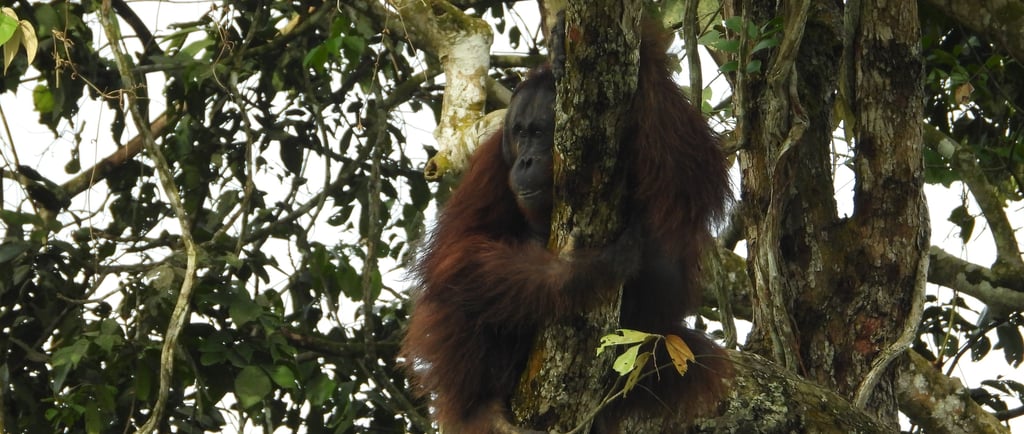PROTECTING THE LARGEST HABITAT OF ORANGUTAN PONGO PYGMAEUS MORIO
12/27/20243 min read


PROTECTING THE LARGEST HABITAT OF ORANGUTAN PONGO PYGMAEUS MORIO
Kalimantan. With an estimated population of only around 5,000 individuals, their numbers are alarmingly low. This dire situation arises primarily due to the continuous degradation and fragmentation of their natural habitat in Kalimantan. As forests are cleared and fragmented, orangutans are often forced into smaller, isolated patches of forest, leading to high potential for human-wildlife conflict. These conflicts occur when orangutans, unable to find adequate habitat, come into contact with human settlements. To address this critical issue, the Wehea-Kelay Landscape initiative was established. This initiative involves multiple stakeholders committed to preserving the orangutan's habitat by connecting various areas, including company conservation zones and protected forests.
The Wehea-Kelay Landscape is situated between Berau and East Kutai districts, covering an area of 532,143 hectares. This extensive landscape is a collaborative effort involving various stakeholders, including the Wehea Forest Management Body, the Wehea Indigenous People, and several management units engaged in landscape activities. The area is also home to seven natural forest timber companies, two plantation forest timber companies, and ten palm oil companies. The collaborative efforts within the Wehea-Kelay Landscape aim to safeguard a critical biodiversity hotspot, which is home to a wide array of flora and fauna.
Protecting the Wehea-Kelay Forest Landscape means safeguarding approximately 721 plant species, with forests covering 87% of the land. Additionally, the area supports 271 bird species, 47 reptile species, 70 amphibian species, and around 1,400 orangutans. The Wehea Protected Forest, a focal point of conservation efforts, harbors around 61 mammal species, including orangutans, 114 bird species, 12 rodent species, 9 primate species, and 59 economically valuable tree species, along with various other flora and fauna. This biodiversity is crucial not only for maintaining ecological balance but also for providing essential ecosystem services that benefit both wildlife and human communities.
Over six months of patrols, rangers documented a total of 100 findings across 66 km of tracked terrain. These findings, categorized into flora, fauna, and disturbances, include 89 identified wildlife sightings comprising 41 primate species, 20 bird species, and 28 mammal species. Analysis methods included tracking, vocalization identification, and direct wildlife encounters. Additionally, 11 findings related to livestock feeding trees were documented. These patrols emphasize identifying feeding trees to understand wildlife migration routes and the distribution of wildlife habitat pockets. This information is crucial for developing targeted conservation strategies and ensuring the protection of critical habitats.
One of the significant challenges faced by conservationists in the Wehea-Kelay Landscape is habitat fragmentation. As human activities such as logging, agriculture, and mining continue to encroach upon the forest, wildlife habitats become increasingly fragmented. This fragmentation isolates wildlife populations, making it difficult for them to find food, mates, and suitable shelter. The Wehea-Kelay Landscape initiative aims to mitigate these effects by creating wildlife corridors that connect isolated forest patches, allowing for the free movement of wildlife and reducing the risk of human-wildlife conflict.
The Wehea-Kelay Landscape is ecologically significant due to its rich biodiversity and the presence of numerous endangered species, including the Pongo pygmaeus morio. Protecting this landscape is not only crucial for the survival of these species but also for maintaining the overall health of the ecosystem. Healthy forests provide essential ecosystem services such as carbon sequestration, water regulation, and soil stabilization, which are vital for both wildlife and human communities.
Conserving the Wehea-Kelay Landscape also provides socioeconomic benefits to local communities. By promoting sustainable land-use practices and eco-friendly livelihoods, conservation initiatives can help improve the well-being of local residents. Ecotourism, for example, can provide a source of income for communities while promoting the conservation of natural resources. Additionally, involving local communities in conservation efforts fosters a sense of ownership and responsibility, which is crucial for the long-term success of these initiatives.
To enhance conservation efforts in the Wehea-Kelay Landscape, it is essential to continue and expand current initiatives. This includes increasing the frequency and coverage of forest patrols, improving wildlife monitoring techniques, and strengthening collaboration with local communities and other stakeholders. Additionally, efforts should be made to restore degraded habitats and create new wildlife corridors to ensure the connectivity of forest patches.
The conservation of the Pongo pygmaeus morio and their habitat in the Wehea-Kelay Landscape is a complex and challenging task that requires the collaboration of various stakeholders. By protecting this critical habitat, we can ensure the survival of this endangered subspecies and the rich biodiversity of the region. The efforts of the Future Forest Foundation, the Wehea Indigenous People, and other stakeholders in the Wehea-Kelay Landscape are crucial for achieving this goal. Through continued collaboration, research, education, and advocacy, we can create a sustainable future for both wildlife and human communities in Kalimantan.